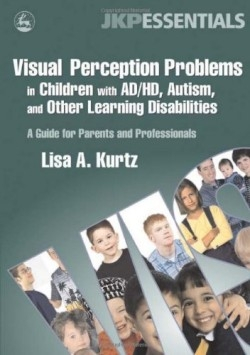Visual Perception Problems in Children with AD/HD, Autism, and Other Learning Disabilities
A Guide for Parents and Professionals
“Some experts contend that as many as 50% of students who experience learning difficulties in school may have some degree of functional vision disorder,” states the author, an occupational therapist with more than thirty-one years of experience working with children who have exceptional needs. Kurtz is also the former Director of Occupational Therapy for the Children’s Hospital of Philadelphia, and has been recognized for her training of others about developmental disorders
Her book focuses on visual difficulties that can easily go undetected, but still greatly impact how a child processes information in the classroom. Macular degeneration is one example of the disorders that Kurtz discusses: “Children with this condition usually have normal peripheral vision, and can move around their environment without significant difficulty, but have significant difficulty using vision to read or process other visual information important to the learning process.” Colorblindness, congenital glaucoma, retinitis pigmentosa, and astigmatism are a few of the other conditions examined.
The author points out that these same visual difficulties can also affect a child’s social behavior. She includes a list of behaviors that a child with visual problems might exhibit, as well as a list of common physical complaints of kids experiencing visual impairments. “Disinterest in or avoidance of activities that require close visual attention,” is mentioned, along with “frequent squinting or rubbing of the eyes,” “frequent headaches during or following reading,” and “nausea or dizziness during or immediately following reading.”
This book is exceptionally practical. Kurtz keeps parents in mind throughout by providing the medical lingo to necessary inform, but not to confuse. She provides a list of organizations that offer vision therapy (both inside and outside the U.S.), suggested questions to ask an eye professional before making an appointment, an explanation of the terminology a parent might find in a medical report, and a list of organizations, along with their web addresses and a one- to two-sentence description of the content at that web site.
Kurtz doesn’t just tell readers about a child’s problem and leave them wondering what to do next. She guides them with excellent ease. This makes for a time-saver, allowing parents and others working with children to focus on speeding the child to visual health.
This volume is compact in size, but abundant in resources. It’s a perfect, easy-to-read resource for parents, teachers, school counselors, tutors, day care providers, and nannies.
Disclosure: This article is not an endorsement, but a review. The publisher of this book provided free copies of the book to have their book reviewed by a professional reviewer. No fee was paid by the publisher for this review. Foreword Reviews only recommends books that we love. Foreword Magazine, Inc. is disclosing this in accordance with the Federal Trade Commission’s 16 CFR, Part 255.

